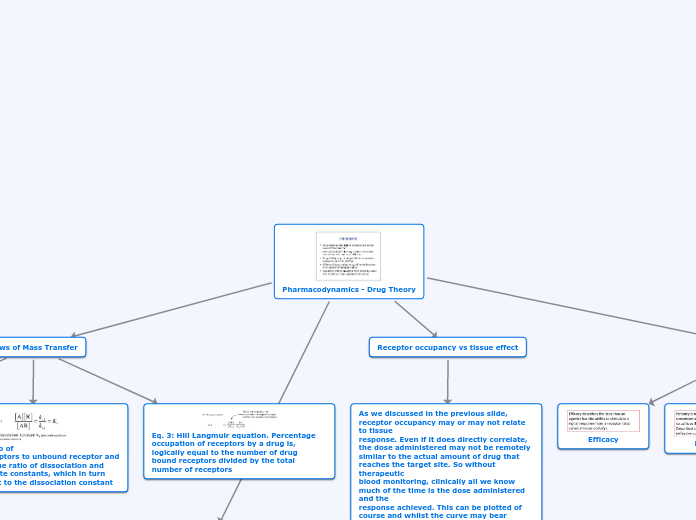Pharmacodynamics - Drug Theory
Laws of Mass Transfer
Eq. 1: the rate of the reaction is
proportional to the product of the concentration of reactants
Eq. 2: the ratio of
occupied receptors to unbound receptor and drug equals the ratio of dissociation and
association rate constants, which in turn are equivalent to the dissociation constant
Eq. 3: Hill Langmuir equation. Percentage occupation of receptors by a drug is, logically equal to the number of drug
bound receptors divided by the total number of receptors
Receptor occupancy vs tissue effect
As we discussed in the previous slide, receptor occupancy may or may not relate to tissue
response. Even if it does directly correlate, the dose administered may not be remotely
similar to the actual amount of drug that reaches the target site. So without therapeutic
blood monitoring, clinically all we know much of the time is the dose administered and the
response achieved. This can be plotted of course and whilst the curve may bear similarity
to the receptor occupancy curve, the ED50, the dosage required to achieve 50% tissue
response will often be orders of magnitude different from the dosage required to achieve
50% receptor occupancy. Notably however the shape of the curve is similar, and a log scale
is also used again because the effects tend to occur within a narrow concentration range.
Affinity, Efficacy, Potency
Efficacy
Potency
Affinity: Affinity is how avidly a drug binds its receptor or how the chemical forces that cause a substance to bind its receptor.
Population effect > Dose Response
I mentioned in a previous slide that drug responses are not all or nothing, they are graded,
however desired pharmacological outcomes very often are indeed all or nothing. Either
there is pain or no pain, either the patient is awake or asleep and whilst drugs can dose
dependently cause graded levels of pain or consciousness you are only clinically interested
in the maximal effect. When administering a general anesthetic for example, all you are
interested in is whether the patient is conscious or unconscious. Where an effect is all or
nothing for practical purposes, an individual dose response analysis may not be appropriate
but a population response is of clinical value.
